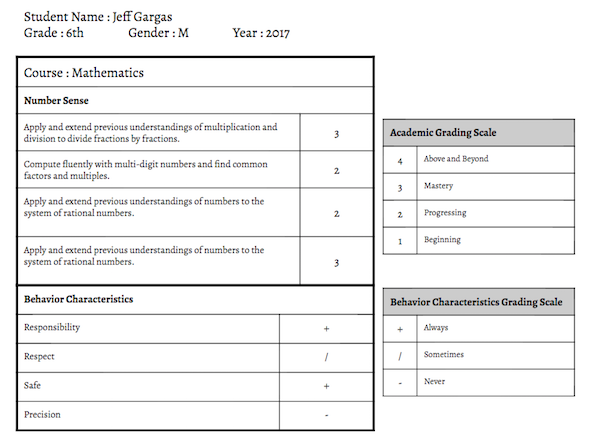In Standards-Based Grading, how do you report a students understanding on a report card?
This may be one of the most widely debated components of Standards-Based Grading. As experts, educators, and administrators conduct research to find the perfect fit for their stakeholders, two major report card types are found to be used most frequently.
Even more important than the look of the reporting document, is for districts to identify the purpose of the report card. It is this answer that can make the right decision for you.
Report Card Questions to Consider
- Who is the major clientele viewing the report card?
- How will the report card be administered?
- What do you want stakeholders to gain from viewing the report card?
- What would you hope to be different about a Standards-Based Grading report card vs a traditional scoring system?
- How often will grades be communicated throughout the year?
- When a stakeholder opens the report card now, what questions or concerns do they currently have?
Report Card Styles
There are two major report card styles currently being utilized in schools that use Standards-Based Grading. Both are supported by the research, however, each addresses differing needs within their designs.
Type #1 : Numerous research outlets support report cards to focus on four major sub categories within each class. Four has been determined to be the “ideal” number of subcategories – allowing the report card to have a proper balance that is not too over whelming for the reader. This approach allows stakeholders to see a break down of student understanding within each sub category.
For example, a Mathematics Course may identify the four categories to be Geometry, Number Sense, Ratios & Unit Rate, and Statistics.
Critics : Often, feedback from this model criticizes the simplicity of this style of reporting. After educators make the shift to a Standards-Based Grading mindset – focused on breaking down student understanding levels into small specific standards – the shift in educator reporting suddenly being averaged into over arching “buckets” is difficult for many to swallow. Some educators voice that this model mirrors gaps already found in the traditional grading model.
Regardless of the critics beliefs, this report card style is vastly different from the traditional gradebook for numerous reasons found within the Standards-Based Grading philosophy, and is commonly adopted as the ideal reporting method for districts. If your district is aiming for reporting to simply be a snapshot of a student’s progress toward mastery and utilize a more detailed system of reporting, continuously accessible to stakeholders – like an online gradebook – this is the report card style for you!
The example below shows a general example of what this report card may look like.
Type #2 : Other school districts have chosen to utilize a more transparent approach – listing all assessed standards within a course. This would mean a Reading course over the quarter, trimester, or semester, would be reporting all assessed standards on the report card. Depending on the class, this could be between 9 – 25 standards per course. This method allows stakeholders to identify specific areas of success and specific areas of improvement for the student.
Critics : This reporting style is often criticized for being overwhelming for its readers. While this style of reporting is extremely detailed, it is commonly multiple pages filled with educational text – difficult for a parent to decipher.
[scroll down to keep reading]Regardless of the critics beliefs, this report card style aims to provide as much information to stakeholders as possible and is commonly adopted as the most effective method to keep everyone involved and informed. If your district is aiming for report cards to provide a detailed picture of a student’s progress toward mastery and is willing to take the time to educate stakeholders on how to effectively decipher the report card, this is the report card style for you!
The example below shows a general example of what this report card may look like.
Remember the Purpose
As you continue to explore possible reporting options for your Standards-Based Grading, it is important to reflect on the purpose behind your report cards. What is the goal?
While their may not be a “perfect” answer, provide yourself the permission to ask questions and hear from what your students, teachers, parents, and administrators need. Collaboration and reflection are essential in any change taking place in the educational system. If you are making choices with students in mind – you can not go wrong!
Continue your exploration with more Standards-Based Grading posts!
- Standards-Based Grading : The Basics
- Standard Based Grading : Understanding a Score
- Standard Based Grading : 4 Pillars
- Standard Based Grading : Combating Common Concerns
- Standard Based Grading : First Steps (video)
- Standard Based Grading : Parent Communication (Coming Soon!)






